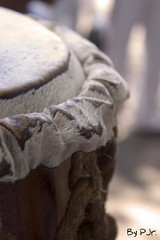Hellohello=]
i'm here to introduce my favorite instrument in the Bataria(ie the band that plays the music you 'jogo' to in the roda consisting of the berimbau, atabaque and pandeiro)
the Atabaque...haha!!!
anyway, for those who are new to capoeira, the Atabaque is basically a drum. Though not the protagonist of the Bataria( that of course goes to the Berimbau, curve bow with a string and a roundround gourd), it is still a important part of the main trio. And together with the Pandeiro(ie tamborine) it helps to reinforce the rhythm played by the Berimbau, giving the songs more depth and acoustical substance....
personally, i find the Atabaque the easiest instrument to pick up. it has 2 basic tones.
-Tone A produces the ''tum tum tum'' sound by hitting the edge of the drum surface with our fingers closed and hands partially cupped. The contact points are the fleshy bits of the palm just below our fingers and the tip section of our finger. Tone A should not be flat and should resonate, and is achieve by hitting and lifting, ie not to let the hand rest on the drum after the hit. those who play the piano or other conventional instruments, its a Staccato hit
-Tone B produces the ''pup pup pup'' sound by slapping the center of the drum surface with fingers open. The contact points for this tone is the entire hand. Tone B should be a loud and flat sound that does not echo or resonate hence the hand is left resting on the drum surface through out the entire count( more on counting and rhythm below) again those who play the piano or other conventional instruments,its a Legato hit
as for counting and rhythm. its actually a 3 bit rhythm. however having said so, we hit the drum 4 times*confusingconfusing* hahaha!! allow me to explain, we count the rhythm as '1,2,3...4...1,2,3...4...1,2,3...4...'. Hit 1 and Hit 2 are half counts of Tone A, ie done fast consecutively,while Hit 3 is a full count of Tone B and Hit 4 is a full counts of Tone A. so......what you get is something that sounds like,
''Tumtum,Pup...Tum... Tumtum,Pup...Tum... Tumtum,Pup...Tum...''
alright before i make this too confusing,click HERE for a simple demo, hopefully it will clarify my attempts to explain playing the Atabaque above....hahaha!!!
on a last note,
-to produce a nice sound on the Atabaque, ones arm, ie shoulder, elbows, wrist, and fingers must always remain RELAX!!!! If the arm is tense, the sound produced is very soft and dead.
-always count out the rhythm(ie actually say out loud the "1,2,3...4...1,2,3...4...1,2,3...4...'' when you play. this not only helps you in keeping the rhythm constant, but it allows you to practice for the future when you no longer need to count out the rhythm, but want to sing to the chorus while playing the Atabaque.
-click HERE to link to another article about playing the Atabaque that includes links to other more uncommon rhythms that one might encounter.
well, i guess this is enough said...the more you play, the more you'll improve and before you know it, you'll be able to not just play the rhythm, and flourishes(improvisation the break from the regular 4 count rhythm buy still stick to the 3 bit rhythm).
Cabure/Pek
p.s. dear fellow snrs, forgive me for the longwinded post with all the explanation and translation. its a intro. post for capoeiristas-to-be la...hahahaha!!!


4 comments:
Well Done Pek!
VERY DETAILED MUSIC CLASS AR
love love
Ei! How did u add yourself under the ABOUT US column? I also want
go to Setting then under Permissions, Add Author, than type in email. but you must have another personal blog account first.
Hey, very good, Pek (even though your REAL name is Pek HONG!)! What on earth is a 'staccato beat'?! The only legolas beat I know is when he is killing orcs with his bow!
Please post some more on the variations you have discovered!
Post a Comment